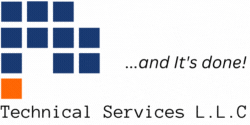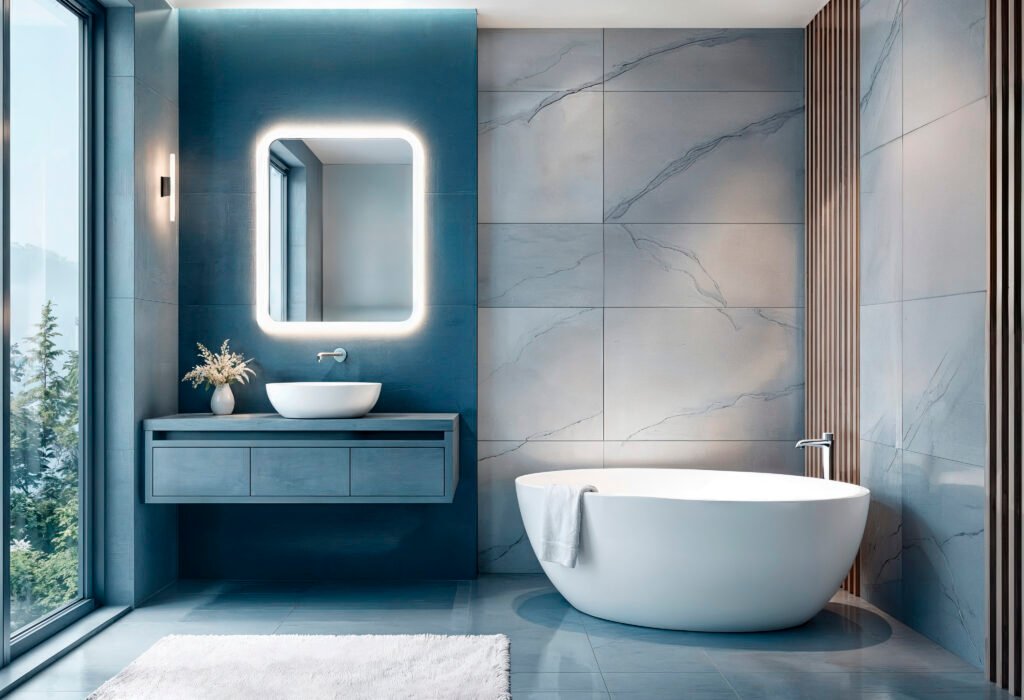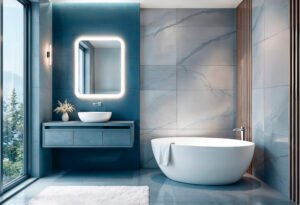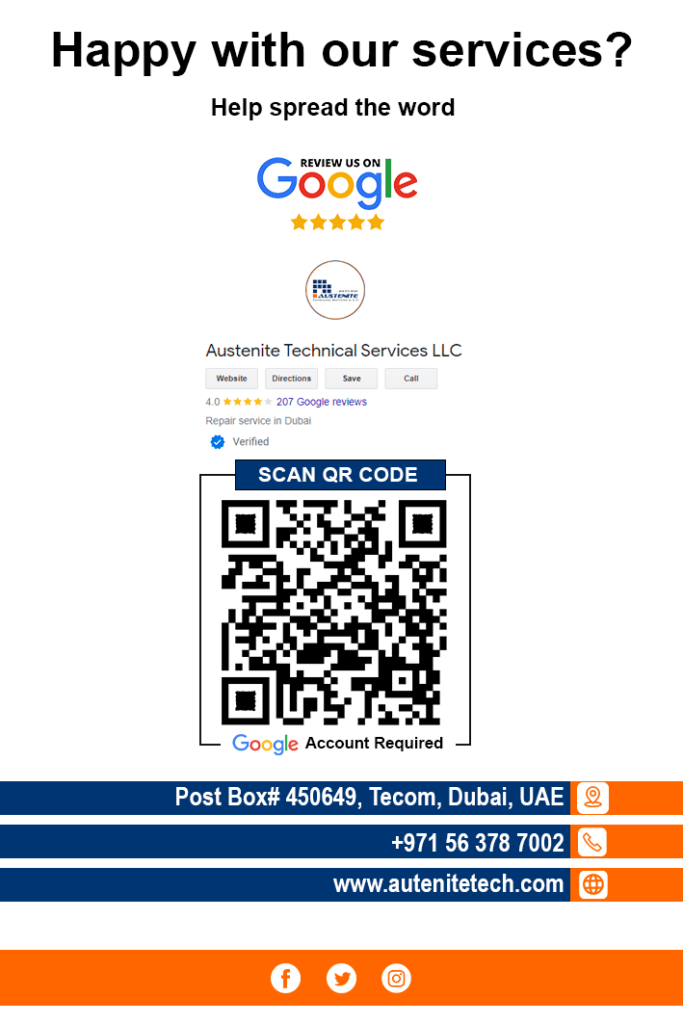-
Smart Bathroom & Automated Fixtures
Dubai continues to push toward high-tech living, and bathrooms are no exception. In 2025, homeowners are increasingly installing:
-
Voice-controlled showers, faucets and mirrors. Imagine saying “set shower to 40°C” and it happens.
-
Smart toilets: heated seats, automatic lid lifts, self-cleaning, built-in bidets, even health-monitoring features.
-
Leak detection & water monitoring systems to avoid damage and waste. With Dubai’s push toward water conservation, these are becoming common.
-
Motion-sensor or touchless elements (taps, lighting) for hygiene and ease.
These features are about comfort & luxury, but also about efficiency and reputation (for resale or prestige).
-
-
Spa-Like Wellness & Natural Elements (Biophilic Design)
Because life in Dubai can be fast-paced, many want bathrooms to be retreats. The trend is toward creating serene, wellness-inspired spaces with:
-
Rain showers, freestanding bathtubs, steam rooms, chromotherapy lighting, heated floors.
-
Natural materials: marble, stone, terrazzo, wood accents. Not just for flooring or counters, but also feature walls.
-
Indoor plants or touches of greenery, bringing in texture and softness.
-
-
Sustainability & Eco-Friendly Features
This is no longer niche; it’s central. Dubai homeowners are showing strong interest in:
-
Water-saving fixtures: low-flow faucets, dual-flush toilets, sensor taps.
-
Energy-efficient lighting (LEDs), smart systems to reduce waste.
-
Use of recycled or eco-certified materials: recycled glass or ceramic tiles, sustainably harvested wood, bamboo, etc.
-
-
Minimalist, Open Layouts & Wet Rooms
Clean lines, unobstructed spaces, and fluid layouts are trending:
-
Wet-room concepts: shower + bath areas that flow without barriers; glass partitions, frameless screens.
-
Floating vanities and wall-mounted fixtures reduce visual clutter and make cleaning easier.
-
Concealed/hideaway storage: niches, built-in cabinets, under-vanity drawers. To preserve the minimalist aesthetic.
-
-
Bold Tiles, Textures & Statement Finishes
To offset minimalism, many are adding personality via finishes:
-
Bold tile patterns, mosaics, geometric designs, even textured or relief tiles on feature walls.
-
Matte black or brushed gold / metallic fixtures for taps, handles, showerheads. These add contrast and elegance.
-
Backlit or ambient lighting: LED light strips under vanities, behind mirrors, hidden lighting to enhance textures.
-
-
Luxury Materials: Marble, Stone & High-End Finishes
For villas, high‐end residences, and anyone wanting a premium feel:
-
Marble and natural stone for walls, floors, countertops. Varieties like Calacatta, Carrara, even more exotic stones are in demand.
-
Onyx, quartzite, and stones with deep veining or translucence for dramatic effect. These materials also resist humidity and heat when chosen properly.
-
Luxury hardware: high quality fittings, designer sinks, freestanding bathtubs with sculptural form.
-
-
Integrated Lighting & Artistic Lighting Design
Lighting isn’t just functional—it’s a mood, a layer of design:
-
Hidden/ambient lighting: LEDs behind mirrors or vanities, under shelves. These soften the space and add luxury.
-
Statement fixtures: pendant lights, dramatic sconces, even small chandeliers in large bathrooms. Used sparingly, but as focal points.
-
Lighting that adapts: dimmable, colour temperature adjustable (cool daylight → warm in evenings). Useful for mood, skin tone, tasks.
-
Why These Trends in Dubai?
-
Climate & Environment: Heat, humidity, and water scarcity make material durability, ventilation, waterproofing, and water efficiency especially important.
-
Luxury Market & Expectations: Dubai residents, especially in villas or high-end apartments, expect high standards. Bathrooms are status spaces.
-
Technological Affluence: There’s a willingness (and ability) to invest in smart systems, automated features.
-
Space Constraints: Many apartments are compact, so maximizing space, reducing visual clutter, and using smart storage are essential.
-
Global Influence + Local Taste: There’s exposure to worldwide design trends, but with local adaptations (e.g. resistance to moisture, avoiding materials that degrade quickly in high humidity, incorporating local aesthetic touches).
Practical Tips for Implementing These Trends
-
Budget properly: high-end materials + smart fixtures cost more. Get multiple quotes.
-
Waterproofing is non-negotiable: even if your finishes are beautiful, without proper waterproofing, things deteriorate fast in Dubai.
-
Plan lighting and ventilation at the start, not as afterthoughts.
-
Prioritize smart features that add daily comfort: good lighting, efficient water/heating.
-
Select materials tested for heat/humidity. For example, some stones may discolor if not sealed properly.
-
Go for modular/flexible designs where possible—things that can adapt over time as your needs change.
Frequently Asked Questions (FAQs)
Q1. How much does a typical bathroom renovation cost in Dubai in 2025?
A: It varies widely depending on size, materials, level of luxury, and whether you’re changing layout or plumbing. Rough guide:
-
Simple cosmetic refresh (tiles, fixtures, paint): lower range.
-
Mid-range renovation (higher quality finishes, perhaps smart fixtures): significantly more.
-
Luxury renovation (premium stone, freestanding bathtubs, full automation): highest cost.
Also, labour and import costs (for materials from overseas) add up. Always get a detailed breakdown.
Q2. What are the best materials for bathrooms in Dubai’s climate?
A: Choose materials that withstand humidity, heat fluctuations, and frequent water exposure:
-
Natural stone (marble, granite) but properly sealed and maintained.
-
Porcelain and ceramic tiles are durable and less porous.
-
Teak or specially treated woods for accents (ventilated well).
-
Waterproof paints or wall panels in areas prone to splash.
Q3. How can I make a small bathroom feel larger?
A: Several tricks that are very effective:
-
Floating vanities and wall-mounted fixtures to free up floor space.
-
Frameless glass shower screens or open wet room design.
-
Large format tiles (fewer grout lines).
-
Light neutral color palettes + good lighting + large mirrors.
-
Clever storage (recessed, hidden) to reduce clutter.
Q4. Are smart fixtures worth the cost?
A: If budget allows, yes—smart fixtures offer comfort, water savings, sometimes energy savings, and improve resale appeal. But pick what you’ll actually use; over-automation that’s rarely used may not justify the cost.
Q5. What should I avoid when renovating a bathroom in Dubai?
A: Some pitfalls:
-
Cutting corners on waterproofing or ventilation (leads to mold, damage).
-
Choosing poor quality or non-sealed materials not suited for high moisture/humidity.
-
Not planning lighting and electrical safely for wet zones.
-
Ignoring maintenance: luxury materials can degrade quickly without upkeep.
-
Overcomplicating layout changes unless necessary (moving plumbing drains etc. can get expensive and time-consuming).









